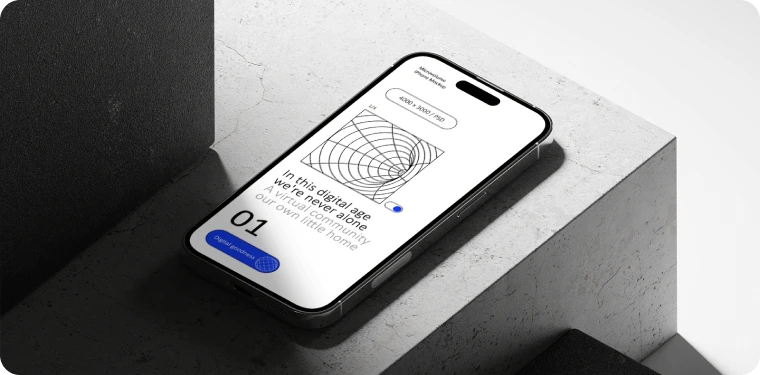How many apps do you have on your smartphone? Clearly, quite a few — a taxi service, pizza delivery, your favorite clothing store, and many other useful ones. A few years ago, the list of apps was much shorter, but today they are an integral part of our daily routine, and for businesses, an essential component of the marketing strategy. Most modern companies can’t do without a mobile app, as it brings brand recognition, attracts new customers, and drives profitability.
Why customers prefer ordering through apps
Getting any service or product through an app is much more convenient than using a website or, even more so, making a phone call. Imagine this situation: you want to order pizza. What’s better — searching for the restaurant’s number in your contacts or online, calling, discussing the details with the manager (what if something gets mixed up or misheard?), agreeing on payment and delivery methods, or just placing the order in the app in a few seconds, without wasting time and energy on unnecessary steps? Of course, most people would choose the latter option. Moreover, we must admit that in the age of rapid technological advancement, modern users are less fond of phone calls and unnecessary personal contact. This is an obvious result of the digitization of the world, and reflects current user behavior, with business apps being a great way not to force the customer out of their comfort zone.
Additionally, in apps, you can view all the necessary information before placing an order, check prices, terms, promotions, and then make an informed decision. If you had to make a phone call or search for a website that may not be optimized for smartphones, the chances of the potential customer proceeding with the order or even getting to the stage of exploring product details are much lower. Leveraging mobile platforms for business significantly shortens the customer’s journey to making a purchase, which ultimately benefits both the customer and the company.
Who Needs Business Apps on the Market
The most relevant use of apps is for companies selling everyday products (clothing, cosmetics, etc.) or providing services to the public. Mobile solutions are also indispensable for:
- food delivery platforms;
- ride-hailing services;
- restaurants and cafés;
- e-commerce stores (offering products that do not require customization);
- fitness and wellness centers.
In each of these cases, the app provides many benefits that are pleasing to the customer and, correspondingly, drive higher order volumes for the business. Let’s take a taxi service as an example. Instead of the complex process involving phone calls, confirming the address, sending messages about order acceptance, and details about the car and payment methods (only in cash), we get a much more streamlined and efficient interaction model.
Ordering a car can be done in a few seconds, choosing the best option in terms of price and additional conditions, such as traveling with a child or pet. There’s no need to make a phone call, the price is clear and fixed. The app automatically detects the client’s location, and they can view the route and the car’s location, which eliminates the problem of finding each other. Additionally, payment can also be made online with automatic card billing — removing the need for cash handling or change.
In turn, companies can announce discounts and special offers in the mobile app. Customers will definitely see them and take advantage when the opportunity arises, while other advertising methods for such offers may go unnoticed. Of course, for the solution to work as effectively as possible, it’s necessary to consider innovations in mobile marketing and the specifics of the niche. For example, for a taxi service, ineffective location tracking or the inability to link a card for online payment would be a critical shortcoming and would not bring the desired results in increasing business profitability.
It’s clear that app development opens up new opportunities for earnings. However, it’s important to analyze how the presence of an app influences revenue and what other benefits mobile solutions offer for businesses.
Staying in Tune with the Latest Trends
For modern young users, the absence of an app for a company signals that it is not keeping up with the times, and therefore automatically becomes uninteresting. A potential customer thinks that if a business hasn’t bothered to develop an app, how can it offer anything interesting, original, or valuable in its service? Of course, this may seem a bit harsh and not always fair, but this is how the modern audience thinks, prioritizing ease, convenience, and relevance, and understanding which innovations in mobile marketing are currently relevant. Therefore, companies need to keep this in mind and even demonstrate their business development and ability to meet customer needs through thoughtful digital solutions.
Expanding the Target Audience
This point builds upon the previous one and is once again focused on youth. If the primary audience for your business is 35+, the presence of an app might not be crucial for them. However, a potential 20-year-old customer, even if your product would be perfect for them, might reject an order simply because they find it inconvenient without an app. From their perspective, it’s outdated, inconvenient, and misaligned with their expectations. If you want to attract a young, active audience, you need to consider their user experience.
Business Profitability and Conversions
As the app attracts new audiences, sales and company revenues increase. However, the app provides many more opportunities for boosting profitability. First, it’s always at hand. There’s a much higher chance that when a person needs a particular service or product, they will think of you, rather than searching for options online.
Second, the app allows you to consistently engage with customers, especially regarding discounts. The same promotional offers on social media are likely to be ignored due to banner blindness. However, if the customer receives a notification on their smartphone that their favorite pizza has a discount, this won’t go unnoticed, and the business can attract many more customers through such promotions. Moreover, the app allows tailored promotions, taking user preferences into account, which further increases profitability.
Key Components of a Convenient App and Marketing Strategies
However, for the business growth after launching an app to be noticeable, it must be done well, thoughtfully, and with maximum use of all available opportunities. The main points to consider when developing the app software to ensure it fully performs its functions are:
- Push notifications— you need to remind users about your app so it isn’t quickly forgotten after installation, but everything should be done strategically with relevant information;
- Geolocation and maps — this is vital not only for taxi services but also useful for other businesses, such as venues or physical stores, so that users can easily find you offline. If you send them a notification like “You’re so close to us, come by and get a bonus,” it could bring in another loyal customer;
- Online payment — this option should always be available, with saved card data so users don’t need to re-enter it each time;
- Quick call — UX/UI for the mobile app should be designed so that all important buttons are always in sight, with one of them being for contacting the administrator. This is essential during the order process, and you shouldn’t make the customer search for contact details outside the app.
Steps for Launching and Maintaining the App
Before starting app development, you should determine which audience you are targeting first and consider their user experience. Don’t try to cover too many features with the app — choose specific functions that it will cater to. For example, for a travel agency, this could be searching for tours based on certain parameters. Think about whether you should add an option for online booking of tours, depending on how relevant this will be for your audience. You might want to test and validate certain additional features.
Plan the UX/UI for the mobile app. The interface should be intuitive, visually appealing, and easy to use. Don’t hide anything, and don’t make the customer take extra steps to place an order. Everything should be comfortable, transparent, and aesthetically pleasing, as required by mobile platform optimization. Choose a platform for app development, create versions for iOS and Android, and ensure compliance with security protocols and scalability requirements. After launching the app, the business should provide regular user support. Consistent updates will provide a positive user experience and improve your image.
Is It Possible to Monetize Apps and Increase Revenue?
Choosing this model for app operation is risky and unpredictable — it can either increase profitability or have the opposite effect. You need to consider your audience’s characteristics and purchasing power. Moreover, this option is not a one-size-fits-all solution. For example, if you only deliver pizza or sushi, the app should just handle order placement and nothing more. It wouldn’t be a good idea to integrate paid features, but for certain niche products, it might make sense. In general, there are several monetization options for apps:
- One-time purchase model — a one-time payment gives access to all features. This can be relevant when creating an app for a specific product, such as a course;
- Ad-supported model — the app is free for users, but the company earns revenue from ads. It’s important to balance the amount of ads to avoid annoying the user and offer a premium version that removes ads;
- In-app purchases — the base version is free, but users need to pay for certain additional features. This option is common in the gaming industry, but a well-thought-out pricing policy is necessary to make it appealing and beneficial to the user;
- Subscription model — a popular model where users pay a monthly fee for usage. This option works well for specific niches, and to retain the audience, you need to constantly update with new and interesting content. It’s particularly effective for apps like language learning platforms or digital media services.
Conclusions
Creating a mobile app is no longer optional but essential for modern businesses, especially those operating in e-commerce. The launch of an app will not be a standalone step for promotion, but rather a part of an integrated development strategy, and in some cases, it may become its key element. In fact, there is no time for hesitation — the absence of an app today is a strategic disadvantage, while its introduction is a way to remain competitive. Only a professional approach to app design, considering the niche, target audience, trends, testing behavioral factors, and providing continuous technical support and improvements, will allow businesses to achieve their desired goals through the app.





